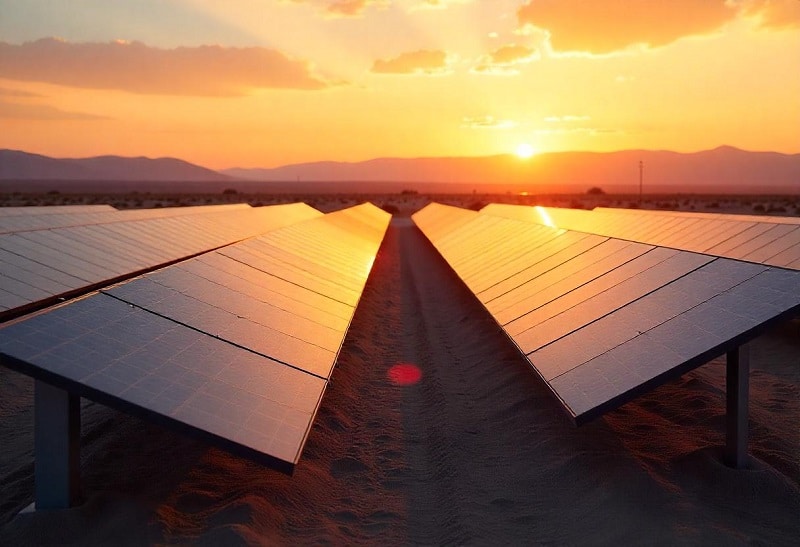Artificial intelligence is transforming industries, but its massive energy demands are creating a lesser-known opportunity for investors. The data centers that power AI consume vast amounts of electricity, driving growth in traditional and renewable energy sectors, power grid infrastructure, and innovative technologies like cooling systems. While tech stocks like Nvidia grab headlines, the companies supplying power, building grids, and optimizing energy use are quietly becoming essential to the AI revolution. For investors, this opens up diverse avenues to diversify portfolios and capitalize on a structural shift in energy demand.
Key Points
- AI’s Energy Demand: Data centers, critical for AI, consumed about 415 terawatt-hours (TWh) globally in 2024, roughly 1.5% of total electricity use, and are projected to more than double to 945 TWh by 2030, per the International Energy Agency (IEA).
- Investment Opportunities: Utilities, renewable energy firms, power grid infrastructure companies, and cooling technology providers are poised for growth as AI drives electricity demand.
- Risks to Consider: Energy market volatility, regulatory hurdles, and long project timelines could impact returns, requiring careful due diligence.
- Balanced Approach: A mix of stable utilities, high-growth renewables, and niche tech plays can offer both stability and upside potential.
Getting Started
Investors can explore individual stocks for targeted exposure or use exchange-traded funds (ETFs) like the iShares Global Clean Energy ETF (ICLN) for broader coverage. Balancing stable, dividend-paying utilities with higher-risk, high-reward renewable and tech plays can align with various risk tolerances.
The Energy Infrastructure Powering the AI Boom: A Comprehensive Guide for Investors
Imagine asking your favorite AI chatbot a question. It responds instantly, but behind that answer is a whirlwind of computation—and a surprising amount of electricity. Now multiply that by billions of queries daily, and you start to see the scale.
Artificial intelligence is a power-hungry beast, and its appetite is growing. Data centers, the nerve hubs of AI, consumed about 415 terawatt-hours (TWh) of electricity globally in 2024—roughly the same as Italy’s total consumption. By 2030, the International Energy Agency (IEA) projects this could more than double to 945 TWh, exceeding Japan’s current electricity use.
For investors, this isn’t just a fun fact—it’s a goldmine. The companies powering these data centers, from utilities to renewable energy firms, are quietly positioning themselves as the backbone of the AI revolution. While everyone’s chasing tech stocks, the smart money might be in the wires, turbines, and cooling systems keeping AI alive.
Below, I’ll show you how AI’s energy footprint is creating investment opportunities in traditional and renewable energy, infrastructure, and related technologies. I’ll break down the sectors, highlight key players, assess risks, and offer practical steps to build a portfolio that taps into this trend.
The Energy Hunger of AI: A Wake-Up Call
Let’s start with the numbers that make your jaw drop. In 2024, data centers accounted for about 1.5% of global electricity consumption, or 415 TWh, according to the IEA . That’s grown at a blistering 12% per year since 2017—four times faster than overall electricity use.
By 2030, the IEA forecasts data center demand will hit 945 TWh, and by 2035, it could reach 1,200 TWh in a base case scenario, with a range of 700–1,700 TWh depending on efficiency and adoption rates. In the U.S., data centers are expected to drive nearly half of electricity demand growth by 2030, outpacing industries like steel and cement combined.
Why is AI so thirsty for power? Training large language models like GPT-4 or Google’s Gemini involves running thousands of GPUs—specialized chips that guzzle electricity. Training a single model can use as much power as a small town for a year. Then there’s inference, the process of using these models to answer queries or make predictions, which keeps data centers running 24/7. Add in cooling systems—servers generate heat like nobody’s business—and you’ve got a recipe for massive energy consumption. Cooling alone can eat up 40% of a data center’s power budget.
This energy surge isn’t a problem; it’s a signal. The companies meeting these demands—utilities, grid operators, renewable energy providers, and tech innovators—are set to see significant growth. Let’s explore the investment opportunities.
Data Center Infrastructure: The Heart of AI
Data centers are where AI lives, and they’re multiplying fast. Tech giants like Amazon, Microsoft, and Google are pouring billions into new facilities. Google alone plans to spend $75 billion on AI infrastructure in 2025, per MIT Technology Review . But servers don’t run on hopes and dreams—they need power, and lots of it.
Utilities: The Steady Giants
Utilities are the first stop. These companies supply the electricity that keeps data centers humming. In regions like Northern Virginia, home to the world’s largest data center hub, utilities are seeing unprecedented demand. Dominion Energy, for instance, expects data centers to drive 80% of its load growth over the next decade. NextEra Energy, a leader in both traditional and renewable energy, is also capitalizing on this trend, with a focus on clean power to meet tech companies’ sustainability goals.
Utilities offer stability. Many are regulated monopolies, meaning they face less competition and pay consistent dividends—NextEra’s yield is around 3%. But they’re not immune to risks. Rising interest rates can increase borrowing costs for capital-intensive projects, and regulatory caps can limit profits. Still, for investors seeking a low-volatility entry into AI’s energy boom, utilities are a solid bet.
| Company | Sector | Key Strength | Risks |
|---|---|---|---|
| Dominion Energy | Utility | Dominant in data center-heavy Virginia | Regulatory caps, interest rates |
| NextEra Energy | Utility/Renewable | Leader in clean energy, strong dividends | Market volatility, policy shifts |
Power Grid Infrastructure: The Unsung Heroes
Data centers need more than just electricity—they need a robust grid to deliver it. This is where infrastructure companies shine. Quanta Services builds transmission lines and substations, critical for connecting data centers to the grid. Their contracts are swelling as data center construction accelerates. Eaton Corporation, which makes power management equipment like circuit breakers, is another key player, benefiting from the need for reliable backup systems.
These companies aren’t as sexy as AI chipmakers, but they’re essential. Their stocks have seen steady gains, and analysts see room for growth as data center demand continues. The catch? Infrastructure projects have long lead times, and regulatory approvals can delay returns. Patience is key here.
Green Energy: Powering AI with a Conscience
AI’s energy demands are pushing tech companies to go green. Microsoft aims to be carbon-negative by 2030, Google wants 24/7 carbon-free energy by the same year, and Amazon is following suit. This isn’t just PR—it’s driving real demand for renewable energy.
Solar and Wind: The Clean Power Surge
Solar and wind are leading the charge. First Solar, a U.S.-based manufacturer of thin-film solar panels, is seeing increased demand through power purchase agreements (PPAs) with tech firms. These PPAs provide stable revenue, making First Solar a compelling investment. Vestas Wind Systems, a Danish wind turbine giant, is also benefiting as data centers seek dedicated wind farms.
The IEA notes that only about half of AI’s energy demand by 2030 is likely to come from renewables, per The Guardian . This gap highlights the growth potential for solar and wind companies. However, challenges like supply chain disruptions and land use disputes could slow progress.
Energy Storage: The Missing Link
Renewables are intermittent—solar panels don’t work at night, and wind turbines need a breeze. Energy storage bridges this gap, ensuring data centers get power when they need it. Fluence, a joint venture between Siemens and AES, specializes in grid-scale battery systems with AI-driven optimization software. Tesla’s Megapack is another player, used in large-scale projects worldwide.
Storage is a high-growth area but comes with risks: high R&D costs, competition, and reliance on critical materials like gallium, where China controls 99% of global supply, per the IEA. Still, as AI pushes renewable adoption, storage will be critical.
| Company | Sector | Key Strength | Risks |
|---|---|---|---|
| First Solar | Solar | Long-term PPAs with tech firms | Supply chain issues, competition |
| Vestas Wind Systems | Wind | Global leader in wind turbines | Policy dependence, land disputes |
| Fluence | Energy Storage | AI-driven battery optimization | High R&D costs, market competition |
| Tesla (Megapack) | Energy Storage | Established brand, large-scale projects | Volatility, supply chain risks |
Power Grid and Transmission: Upgrading for the Future
Data centers need a grid that can handle their massive loads. Existing infrastructure often falls short, creating opportunities for companies that build and maintain power networks.
MYR Group provides electrical infrastructure services, upgrading grids to support data centers. ABB, a Swiss multinational, makes transformers and switchgear essential for high-capacity transmission. Siemens offers digital solutions for grid optimization, helping utilities manage the variability of renewables.
These investments are capital-intensive and subject to regulatory delays, but they’re crucial for AI’s growth. As grids modernize, these companies stand to benefit.
Innovations in Cooling and Efficiency: The Hidden Goldmine
Data centers are hot—literally. Servers generate so much heat that cooling systems can account for 40% of energy use. This challenge is spawning innovation.
Advanced Cooling Systems
Vertiv designs cooling solutions, from precision air conditioners to liquid cooling systems, tailored for data centers. Schneider Electric offers energy management systems that optimize power and cooling. Both are seeing revenue growth as AI workloads increase.
A wild card is immersion cooling, where servers are submerged in non-conductive liquids. Companies like Submer and LiquidStack are early players, but their smaller size makes them riskier bets.
Energy Efficiency Tech
Efficiency is another frontier. Advanced Energy Industries makes power conversion systems that reduce waste in data centers. These niche players offer high growth potential but may lack the diversification of larger firms.
Global Perspectives: Opportunities Beyond the U.S.
AI’s energy boom is global. China’s LONGi Green Energy dominates solar panel production, while India’s Adani Green Energy is expanding its renewable portfolio. In Europe, Orsted leads offshore wind, supplying clean energy to data centers.
International investing offers diversification but comes with risks like currency fluctuations and geopolitical instability. Research local markets and regulations carefully.
Investing in AI’s energy infrastructure isn’t a slam dunk. Energy markets are volatile, with prices swayed by geopolitical events or weather. Utilities face regulatory caps, while renewables depend on subsidies. Technological advancements could render some investments obsolete.
Due diligence is critical. Look for companies with strong balance sheets and clear exposure to AI-driven demand. Diversification across sectors and geographies can mitigate risk.
Building Your AI Energy Portfolio
Here’s how to get started:
- Individual Stocks: Utilities like NextEra Energy offer stability; infrastructure firms like Quanta Services provide growth; renewables like First Solar and storage players like Fluence offer upside.
- ETFs: The iShares Global Clean Energy ETF (ICLN) or Utilities Select Sector SPDR Fund (XLU) provide broad exposure.
- Balanced Approach: A mix of 40% utilities, 30% infrastructure, 20% renewables, and 10% niche tech can balance risk and reward.
Use platforms like Bloomberg or Morningstar to research financials and analyst ratings. Monitor macro trends like interest rates and climate policies.
The Bigger Picture: Why This Matters
Investing in AI’s energy infrastructure isn’t just about profits—it’s about betting on the future. AI could solve big problems, from curing diseases to tackling climate change, but it needs energy to do so. By investing here, you’re supporting the foundation of innovation.
Think of it like the Gold Rush: the miners got the glory, but the folks selling picks and shovels made bank. Today, AI is the gold, and energy infrastructure is the shovel. Are you ready to dig in?
Key Citations
- IEA Energy and AI Report 2025
- MIT Technology Review: AI’s Energy Footprint 2025
- The Guardian: AI Data Centers Energy Demand 2025
- World Economic Forum: AI Energy Emissions 2024
This article is for informational purposes only and does not constitute financial advice. The author is not an investment advisor and does not hold any financial position, long or short, in any of the stocks or securities mentioned herein.



































